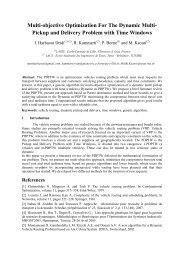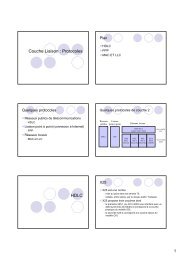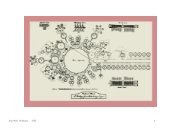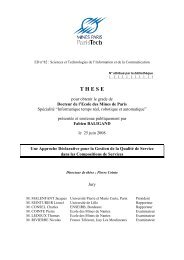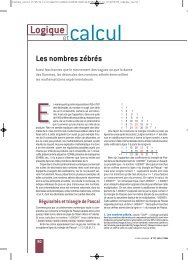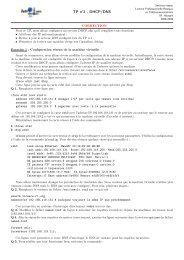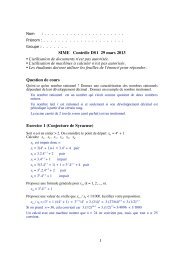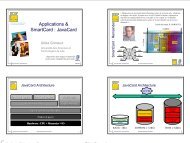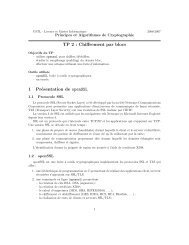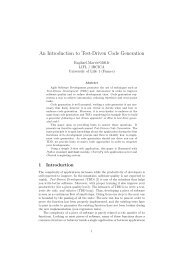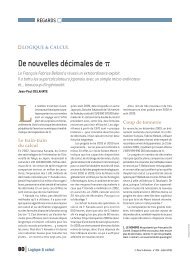TIMMO's Challenges for AUTOSAR Timing Modeling - LIFL
TIMMO's Challenges for AUTOSAR Timing Modeling - LIFL
TIMMO's Challenges for AUTOSAR Timing Modeling - LIFL
- No tags were found...
Create successful ePaper yourself
Turn your PDF publications into a flip-book with our unique Google optimized e-Paper software.
Presentation GoalsIdentify TIMMO expectations on MARTEIdentify how MARTE may help in TIMMOIdentify MARTE concepts useful <strong>for</strong> TIMMO needsEvaluate MARTE completeness and usabilityEvaluating MARTE in Industry: <strong>TIMMO's</strong> <strong>Challenges</strong> <strong>for</strong> <strong>AUTOSAR</strong> <strong>Timing</strong> <strong>Modeling</strong> Munich, March 14th, 2008 2
ITEA TIMMO Project <strong>AUTOSAR</strong> partners (OEMs, Tier-1s, SW suppliers, vendors, research):AUDI, Volkswagen, Volvo, Bosch, Continental, Siemens VDO & IT, ZF,ETAS, Symtavision, TTTech, Chalmers, Paderborn, CEA,… TIMMO goals:Enable reasoning about timing and define models & parameters <strong>for</strong> thispurposeEnable new process steps (methodology) and provide tool supportUse existing architectures as reference: <strong>AUTOSAR</strong> plus one or twoabstraction levels (tentatively provided by EAST-ADL2) TIMMO will consider inputs from <strong>AUTOSAR</strong> timing team:Start bottom-up, otherwise danger of loss of semanticsStart with simple use cases and examples, otherwise “too big” problemsEvaluating MARTE in Industry: <strong>TIMMO's</strong> <strong>Challenges</strong> <strong>for</strong> <strong>AUTOSAR</strong> <strong>Timing</strong> <strong>Modeling</strong> Munich, March 14th, 2008 3
Background & MotivationTIMMO Focus: End-to-end <strong>Timing</strong> Calculation of response times (function exec./message transmission):End-to-end timing chains (e.g., from sensor to actuator over a network) Taking into account timing dependencies...preemptions, blocking, buffering, data-dependent execution times,… In order to study timing problems…Overload, miss deadlines, buffer overload, stability of distributed controlEvaluating MARTE in Industry: <strong>TIMMO's</strong> <strong>Challenges</strong> <strong>for</strong> <strong>AUTOSAR</strong> <strong>Timing</strong> <strong>Modeling</strong> Munich, March 14th, 2008 4
TIMMO Expectations on MARTE TIMMO can benefit from MARTE:Semantically, because of the MARTE timing analysis basisSyntactically, because MARTE has defined many common timing aspects Preliminary TIMMO expectations on MARTEstructure? (abstraction levels, components, flexibility)experience of using UML-like approach <strong>for</strong> timing modelingpractical experience (proof of concept, ef<strong>for</strong>t, tool-support)compatibility with: <strong>AUTOSAR</strong> / OSEK-VDX / FlexRay, etc.which MARTE parts must be considered? TIMMO asks "reasonable" ef<strong>for</strong>t to specify models that are supportedby existing analysis/simulation tools“There is no point in modeling something thatcannot be analyzed” (during an <strong>AUTOSAR</strong> timing team meeting)Evaluating MARTE in Industry: <strong>TIMMO's</strong> <strong>Challenges</strong> <strong>for</strong> <strong>AUTOSAR</strong> <strong>Timing</strong> <strong>Modeling</strong> Munich, March 14th, 2008 5
How to evaluate MARTE? The “import” approach is not feasible in TIMMO:An architectural view already exists <strong>AUTOSAR</strong> metamodelSome timing basic concepts are already under way <strong>AUTOSAR</strong> <strong>Timing</strong>sub-group Be<strong>for</strong>e syntactic and technological aspects,concepts and semantics need to be evaluated Look at the MARTE domain model firstFree of syntactical concerns (UML syntax). Missing points need to precisely be quantifiedConceptual, semantic, or parameter insufficiency?Need to enhance the MARTE spec.?Evaluating MARTE in Industry: <strong>TIMMO's</strong> <strong>Challenges</strong> <strong>for</strong> <strong>AUTOSAR</strong> <strong>Timing</strong> <strong>Modeling</strong> Munich, March 14th, 2008 6
A Typical Scenario of MARTE Utilization-Function allocation-Task allocation-Scheduling parameters defs-DeploymentTime- & resourceconstrainedsystem model->E.g., GQAMEvaluating MARTE in Industry: <strong>TIMMO's</strong> <strong>Challenges</strong> <strong>for</strong> <strong>AUTOSAR</strong> <strong>Timing</strong> <strong>Modeling</strong> Munich, March 14th, 2008 7
MARTE Structure <strong>for</strong> <strong>Timing</strong> AnalysisWorkloadBehaviorResourcesPlat<strong>for</strong>mworkloadeventsend-to-end flowsstepsexec.hostshared resourceschedulableresourcescomm.hostDefine “analysis” abstractionsworkload events, schedulable entities, processing nodes…Concept attributes define non-functional propertiese.g. event arrival patterns, end-to-end deadlines, wcet-bcet-acet,…Evaluating MARTE in Industry: <strong>TIMMO's</strong> <strong>Challenges</strong> <strong>for</strong> <strong>AUTOSAR</strong> <strong>Timing</strong> <strong>Modeling</strong> Munich, March 14th, 2008 8
Typical Non-Functional <strong>Timing</strong> In<strong>for</strong>mation Input in<strong>for</strong>mation:Scheduling strategies <strong>for</strong> resources (CPU, Buses)Access control protocols <strong>for</strong> shared resources (memory, peripherals, etc.)Worst/best case execution times of individual actions (steps) or length ofmessages to be transmitted by busesOS overheads.The activation frequency/period and deadlines of end-to-end flows Output in<strong>for</strong>mation(end-to-end) worst/best case response times, response time jittersProcessor and bus utilizationsGlobal and per-processor schedulabilityEvaluating MARTE in Industry: <strong>TIMMO's</strong> <strong>Challenges</strong> <strong>for</strong> <strong>AUTOSAR</strong> <strong>Timing</strong> <strong>Modeling</strong> Munich, March 14th, 2008 9
Basic Mapping MARTE Analysis vs. <strong>AUTOSAR</strong>MARTE conceptEnd-to-end flowWorkload eventStep (ExecStep, CommStep)Execution HostCommunication HostShared ResourceSchedulable Resource<strong>Timing</strong> Observer<strong>AUTOSAR</strong> conceptNone<strong>Timing</strong>EventRunnable EntityECU??None(OS) TaskNoneEvaluating MARTE in Industry: <strong>TIMMO's</strong> <strong>Challenges</strong> <strong>for</strong> <strong>AUTOSAR</strong> <strong>Timing</strong> <strong>Modeling</strong> Munich, March 14th, 2008 10
The Notion of End-To-End FlowAn “End-To-End Flow” is the basic workload unit to evaluate An end-to-end flow refers to the entire causal set of steps triggered by one ormore external workload events.Workload event: basic stimuliunit (e.g., timers, externaloccurrences, internalevents,…)Step: basic behavioralunit (e.g., executionactions, call actions,message sending,…)processing times (worstand best case)Evaluating MARTE in Industry: <strong>TIMMO's</strong> <strong>Challenges</strong> <strong>for</strong> <strong>AUTOSAR</strong> <strong>Timing</strong> <strong>Modeling</strong> Munich, March 14th, 2008 11
Over/under Sampling•single-buffered registers: „last is best“, i.e. new data overwrites old ones,•important <strong>for</strong> undersampling•in oversampling, several possibilities exist•timing of first data that goes through•timing of last data (maximum age)Evaluating MARTE in Industry: <strong>TIMMO's</strong> <strong>Challenges</strong> <strong>for</strong> <strong>AUTOSAR</strong> <strong>Timing</strong> <strong>Modeling</strong> Munich, March 14th, 2008 12
Resources ConceptsProvide additional (analysis-specific) annotations to annotate resources plat<strong>for</strong>mmodelsProcessingresources(execution andcommunication)SchedulerShared ResourcesSchedulable resources(e.g., threads,channels,…)Evaluating MARTE in Industry: <strong>TIMMO's</strong> <strong>Challenges</strong> <strong>for</strong> <strong>AUTOSAR</strong> <strong>Timing</strong> <strong>Modeling</strong> Munich, March 14th, 2008 13
Analysis Context conceptsEvaluating MARTE in Industry: <strong>TIMMO's</strong> <strong>Challenges</strong> <strong>for</strong> <strong>AUTOSAR</strong> <strong>Timing</strong> <strong>Modeling</strong> Munich, March 14th, 2008 14
Mapping Steps into Schedulable ResourcesTasksCat 1Cat 2Runnable entityCategory 1 or 2(a) <strong>AUTOSAR</strong> basic task mappingEvaluating MARTE in Industry: <strong>TIMMO's</strong> <strong>Challenges</strong> <strong>for</strong> <strong>AUTOSAR</strong> <strong>Timing</strong> <strong>Modeling</strong> Munich, March 14th, 2008 15
Conclusions We suggest to look at the MARTE domain model first Semantics compatible with a set of analysis techniques and tools Completeness/oversize Some aspects are not supported by MARTE (e.g. FlexRay params.) Some others existing in MARTE are not supported in commercialtools Some modeling practices should be taken into account: Explicit behavior models, parameterization, rich non-functional datatypes, model compositionEvaluating MARTE in Industry: <strong>TIMMO's</strong> <strong>Challenges</strong> <strong>for</strong> <strong>AUTOSAR</strong> <strong>Timing</strong> <strong>Modeling</strong> Munich, March 14th, 2008 16
Questions?Evaluating MARTE in Industry: <strong>TIMMO's</strong> <strong>Challenges</strong> <strong>for</strong> <strong>AUTOSAR</strong> <strong>Timing</strong> <strong>Modeling</strong> Munich, March 14th, 2008 17



